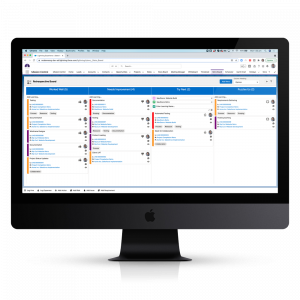The Lowdown on Project Retrospectives
Don’t look back, right? Well, no, not exactly. In fact in project management we actively encourage some reflection. But how we reflect, capture and action key project learnings can directly impact the ongoing success of future projects. In this article, we take a closer look at project retrospectives, what they are, when to use them and how to best facilitate them for ongoing business improvement.
What is a Project Retrospective?
These can go by many names: Project debriefs, reviews, learnings workshops or retro ceremonies – but in essence they’re the same thing: An opportunity to collectively reflect on past events to improve the future.
Why are Retrospectives Important?
Put simply, for business improvement. The more projects we run, the more experience we get…but it’s how we learn from that experience that is the critical part of retrospectives. Making time and space to explore those learnings allows organizations to improve and evolve their offering; critical for staying relevant in an ever-changing landscape. Retrospectives can be instrumental in driving change, whether that’s organisational, team, process or all.
The ongoing documentation of retrospectives can also safeguard against losing business IP with staff turnover. By creating and maintaining a lessons learned log, important insights are kept within the business. This in turn can support an efficient onboarding and upskilling of new team members if previous project learnings are made readily accessible.
When is it best to undertake a Retrospective?
This really comes down to your business and the types of projects you run. For some, it might work well to run one overall retrospective at the end of a project. For others, it might make more sense to complete a retrospective each time a project milestone or sprint is completed within a project. It’s about finding a balance that works for your business – somewhere between getting work completed within scope, time and budget whilst being open to some flexibility and improvements along the way. Explore what works and then commit to a cadence that best suits.
How should retrospectives be structured?
Again, there’s no golden rule here but there are some guiding principles that we’ve used to inform the development of our Retrospective Board feature within Mission Control. Here’s how we ensure we get the most out of our retrospectives every time:
1. Preparation
Remember what you had for dinner two Thursdays ago? Us neither. And asking a team to recall details of project intricacies when they’re much further down the line can present recall challenges too. The key to a successful retro is to ensure you’re working from the best insights. And the best way to get these? In real-time! At the beginning of a project, put a system in place for the project team to document and track learnings as they go. We recommend avoiding a free-for-all scenario by instead setting up a structured system that captures key information in a way it will be easy to review on bulk – not just on this project but cross-referencing with other projects too. Ensure the information you’re capturing is consistent, which will allow you to search and filter lessons learned now and in the future.
At Mission Control, we set up a Retrospective at the beginning of each project / sprint. Within each Retrospective, team members can create Learnings that include important details on who is recording it, what project and category (project phase) it is associated with and how it’s rated (worked well / needs improvement / try next /puzzles us).
2. Engage the team
Your project learnings are only as good as what’s being documented by your team, so it’s essential they’re engaged from the project off-set. Set expectations of the sort of feedback you’re hoping to capture by sharing examples of what project learnings could look like – the good, the bad and the confusing. Be sure to communicate that retrospective ceremonies are not just a place to share negative feedback – they’re also about celebrating successes. It can be easy to concentrate on everything that needs improvement but it’s also business critical that the team are recording what’s working well too. This allows business leaders to explore the all-important ‘why’ and then consider how this may be replicated across other areas of a project.
3. Track as you go
As a Project Manager, it can be useful to gauge how a project is rolling-out by taking a look at the lessons learned log being recorded (in between ceremonies). At Mission Control we do this in the Retro Tab on the Project Overview. It can be easily filtered to see not only the number of Learnings that have been recorded but also what categories are generating the most Learnings (e.g. resourcing / scoping / testing…etc) and arguably the most important one, what’s perceived to be working and what’s not. It’s important not to be too reactive to these but rather use them as a soft indicator of how a team is going with a project roll-out.
4. Create an agenda
A retrospective ceremony should be interactive and collaborative – this is what will generate the most fruitful discussions and allow more in-depth exploration of potential improvements. But it’s essential it is structured so the session itself maintains momentum and delivers the desired outcome. At Mission Control, we use the Retrospective Board (a Kanban board) to inform our discussions. An agenda could look something like:
- Objective: Set the tone for the ceremony and communicate expected outcomes e.g. 3 – 5 things to maintain, improve, stop…etc.
- Learnings: Ask questions and listen:
- What worked?
- What needs improvement?
- What is confusing?
- What could we try next?
- Actions / changes moving forward: Create tangible actions for improvement
- Prioritize actions and assign owners: Document and ensure buy-in from team
- Summary

5. Allow the team time to prepare
Retrospective ceremonies should ideally be scheduled at least a week or so before they take place. This allows the project team time to review individual lessons learned and consider if their perception of these has changed now that the project / sprint has been completed. It also allows time to consider what and how they want to communicate during the ceremony. Ideally team members should be coming armed with ideas, suggestions and potential solutions for improving future projects.
6. Don’t make it personal
Retrospective ceremonies are not about encouraging a blame culture. Far from it. By constructively reflecting on areas of improvement – and also successes – retrospectives can provide an opportunity for teams to engage, feel heard and have an influence in shaping the direction of future projects. This can be pretty empowering to all involved. Each member of a project team holds important information on how it ran so providing a safe space for that to be voiced is important. At Mission Control, we built in an ‘Opinions’ value for team members to rate their position on the Learning. This rating can be changed as a project progresses – because sometimes as a project unfolds, our perspective does too.
7. Compare and contrast
Once you’ve undertaken a few retrospectives, you’ll have a powerful set of project lessons learned at your disposal. It can be an interesting and worthwhile exercise to compare these in order to identify trends across the business. Also take a look at outcomes and actions from other retrospectives and review if these have successfully instigated changes – or as a business, are you still facing the same challenges every time? What strategies have been explored for improvement and what could be tried next?
Retrospectives are an integral component in driving business improvement. They allow businesses to strategically address learnings and feedback and unite a team in moving forward and growing together. To learn more about how Mission Control’s Retrospective Board feature could benefit your organization, contact our team today.




